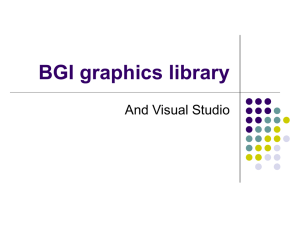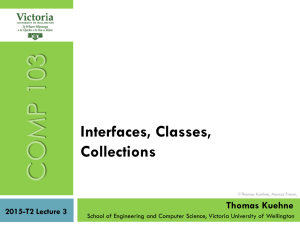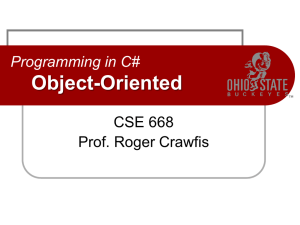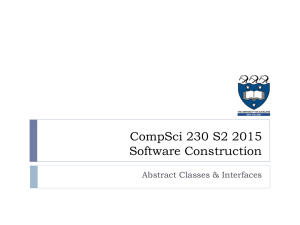C# and Software Design notes
advertisement
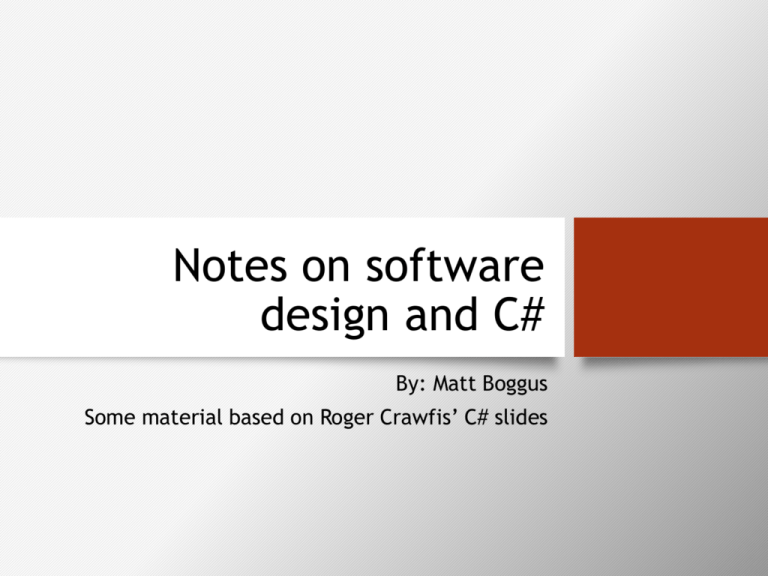
Notes on software
design and C#
By: Matt Boggus
Some material based on Roger Crawfis’ C# slides
Outline
• Defining high quality software
• C# syntax and examples
•
•
•
•
•
Classes and structs
Interfaces
Abstract classes
Class internals
Type conversion
• Demo of development environment
Some characteristics of
high quality software
•
•
•
•
Simple
Readable
Maintainable
Reusable
• For more specific qualities/principles,
read up on SOLID (object-oriented design)
Simple
• Composed of a single
element; not compound
• Complexify: to make
complex
• Complect: intertwine;
interweave; to combine
• Related software design
principles
• SOLID: Singular
Responsibility Principle
• SOLID: Interface
segregation principle
• Separation of Concerns
• Don’t Repeat Yourself
Image from
https://bagntell.files.wordpress.com/
2012/02/four_string_braided-strap.jpg
Readable
• Function of
•
•
•
•
Naming conventions
Formatting (white space)
Control flow (problem decomposition)
Reader’s experience with the language
• See blockExample classes
Maintainable
• Ease of the following tasks:
• isolate defects or their cause,
• correct defects or their cause,
• repair or replace faulty or worn-out components without
having to replace still working parts,
• prevent unexpected breakdowns,
• maximize a product's useful life,
• maximize efficiency, reliability, and safety,
• meet new requirements,
• make future maintenance easier, or
• cope with a changed environment.
• We’ll come back to this with the Person*.cs examples
Reusable
• Reuse of existing
code in other
projects
• Related software
design principle
• Composition over
inheritance
Identical Panel Gag image from
http://tvtropes.org/pmwiki/pmwiki.php/ComicBook/Invincible
Two programming paradigms
• Object-oriented
Programming
• Focus on readability
• Objects are an
abstraction to be used by
client programmers, and
should follow a mental
model of the actual or
imagined object it
represents
• Objects are “nouns” that
have fields “adjectives”
and methods “verbs”
• More discussion on why
OOP is useful here
• Entity-Component System
• Focus on reusability
• Software should be
constructed by gluing
together prefabricated
components like in
electrical engineering
• Functionality is attached
to an object instead of
inside its implementation
Why C#?
• Fits with
• .NET framework
• Large library of features and objects; portable and integrates with
software written in other languages
• Visual Studio
• Single point of access for software development, source code
control, project management, and code reviews
• Additional reasons
• Game engines support C# -> XNA, Monogame, Unity
• Used in other CSE graphics courses (Game and Animation
Techniques; Game Capstone)
• More discussion of pros/cons of C# here
• More discussion of pros/cons of C# specific to game development
here; this subset of comments has some good insights
C# language features
• Namespaces
• Classes
•
•
•
•
Fields
Properties
Methods
Events
• Structs
• Enums
• Interfaces (contracts)
• Methods
• Properties
• Events
• Control Statements
• if, else, while, for, switch, foreach
C# and Java similarities
• All classes are objects
• Compare System.Object to java.lang.Object
• Similar compilation and runtime to Java
• Compare Java Virtual Machine to Common Language
Runtime
• Heap-based allocation
• Use “new” keyword to instantiate
• Automatic garbage collection
Java to C# resources
• Java for C# developers – fairly brief syntax and
terminology differences
• The C# Programming Language for Java
Developers – documentation of language
differences organized by programming
constructs
• Additional Suggestions from StackOverflow
Classes vs. Structs
Classes vs. structs
• Both are user-defined types
• Both can implement multiple interfaces
• Both can contain
• Data
• Fields, constants, events, arrays
• Functions
• Methods, properties, indexers, operators,
constructors
• Type definitions
• Classes, structs, enums, interfaces, delegates
Classes vs. structs
Class
• Reference type
Struct
• Value type
• Original instance of
the object can be
modified during
execution of method
bodies
• A copy of the object
is made and
operated on inside
method bodies
Note: Many types in XNA are defined as structs (ex: Vector2 and Rectangle)
Can pass structs as reference type using ‘ref’ keyword
Class syntax example
public class Car : Vehicle
{
public enum Make { GM, Honda, BMW }
private Make make;
private string vid;
private Point location;
Car(Make make, string vid, Point loc)
{
this.make = make;
this.vid = vid;
this.location = loc;
}
Car c =
new Car(Car.Make.BMW,
“JF3559QT98”,
new Point(3,7));
c.Drive();
public void Drive()
{ Console.WriteLine(“vroom”); }
}
Interfaces
Interfaces
• An interface defines a contract
• An interface is a type
• Contain definitions for methods, properties,
indexers, and/or events
• Any class or struct implementing an interface
must support all parts of the contract
• Interfaces provide no implementation
• When a class or struct implements an interface
it must provide the implementations
• SOLID: Depend upon abstractions not
concretions
Interfaces
• Explicit interface
• Requires/ensures clauses or pre/post-conditions
• Functionality is explicitly defined
• Implicit interface
• Only method signatures are specified
• Ex:
IBird interface defines void Fly()
Duck class implements void Fly { position.y += 5; }
Penguin class implements void Fly { // no-op }
Interfaces example
public interface IDelete {
void Delete();
}
public class TextBox : IDelete {
public void Delete() { ... }
}
public class ImageBox : IDelete {
public void Delete() { ... }
}
TextBox tb = new TextBox();
tb.Delete();
IDelete deletableObj = new ImageBox();
deletableObj.Delete();
deletableObj = new TextBox();
deletableObj.Delete();
Object and interface design
• Keep it simple!
• The Magical Number Seven, Plus or Minus Two
• The average person can hold 7 ± 2 objects in memory at
a time
• Experts recall more by “chunking” – combining multiple
objects into one
• Think You're Multitasking? Think Again
• The average person is bad at multi-tasking, so focus on
what you’re doing if you want it done well
• Only provide the minimum amount of functionality
required
• SOLID: Open to extension, but closed to modification
Abstract Classes
Abstract class
• Similar to interfaces
• Cannot be instantiated
• In some cases, contain no executable code
• Can contain method headers/signatures and properties
(more on these in a bit), but unlike interfaces they
can contain concrete elements like method bodies
and fields
• Some quirks when working with abstract classes
and interfaces
• A class that is derived from an abstract class may still
implement interfaces
• A concrete class may implement an unlimited number
of interfaces, but may inherit from only one abstract
(or concrete) class
public abstract class Shape
{
protected int x = 50;
protected int y = 50;
Abstract class
example
public abstract int Area();
}
public class Square : Shape
{
public int width;
public int height;
public override int Area()
{
return width * height;
}
public void MoveLeft()
{
x--;
}
}
Methods marked as abstract have
no bodies and must be overridden
Methods marked as virtual have
bodies and may be overridden
See
http://msdn.microsoft.com/enus/library/sf985hc5.aspx for a
longer example
Class internals
this
• The this keyword is a predefined variable
available in non-static function members
• Used to access data and function members
unambiguously
public class Person
{
private string name;
public Person(string name)
{
this.name = name;
}
public void Introduce(Person p)
{
if (p != this)
Console.WriteLine(“Hi, I’m “ + name);
}
}
base
• The base keyword can be used to access class
members that are hidden by similarly named
members of the current class
public class Shape
{
private int x, y;
public override string ToString()
{
return "x=" + x + ",y=" + y;
}
}
public class Circle : Shape
{
private int r;
public override string ToString()
{
return base.ToString() + ",r=" + r;
}
}
Fields
• A field or member variable holds data for a
class or struct
• Can hold:
A built-in value type
A class instance (a reference)
A struct instance (actual data)
An array of class or struct instances
(an array is actually a reference)
• An event
•
•
•
•
Field examples
static and instance
public class Variable
{
public static int i = 10;
public int j = 1;
public void test()
{
i=i+10;
j=j+1;
Console.WriteLine(i);
Console.WriteLine(j);
}
}
public class Exercise
{
static void Main()
{
Variable x = new Variable();
x.test();
Variable y = new Variable();
y.test();
Console.ReadKey();
}
}
• Output is:
20
2
30
2
Properties
• Client side looks like a field
• Internally behaves like method calls to get or
set the field (i.e. more abstract than a field)
• Properties encapsulate a getting and setting a
field
• Useful for changing the internal type for a field
• Useful for adding code or breakpoints when
getting/setting a field
Properties – examples
• type PropertyName { get; set; }
• Examples
int Score { get; set; }
string Name { get; }
double Time { get; private set; }
• Code examples
• Person*.cs examples [Compare maintainance]
• http://www.dotnetperls.com/property
Modifiers
• Public
•
Accessible anywhere
• Protected
•
Accessible within its class and by derived class instances
• Private
•
•
Accessible only within the body of the class
(Or anywhere if you use reflection)
• Internal
•
•
Intuitively, accessible only within this program (more specific definition here)
The default, but you should generally pick public or private instead
• Static
•
Belongs to the type
• Instance
•
Belongs to the instance
Access modifier error example
interface GameObject // no access modifier, defaults to internal
{
void Draw();
void Update();
}
public class Monster : GameObject
{
// ... implementations of Draw() and Update() go here ...
}
• Cannot have a base class (including interfaces) class less
accessible than a concrete class that derives from it
Conversion
Conversion operators
• Can also specify user-defined explicit and
implicit conversions
public class Note
{
private int value;
// Convert to hertz – no loss of precision
public static implicit operator double(Note x) {
return ...;
}
// Convert to nearest note
public static explicit operator Note(double x) {
return ...;
Note n = (Note)442.578;
}
double d = n;
}
The is Operator
• The is operator is used to dynamically test if
the run-time type of an object is compatible
with a given type
private static void DoSomething(object o)
{
if (o is Car)
((Car)o).Drive();
}
The as Operator
• The as operator tries to convert a variable to a
specified type; if no such conversion is
possible the result is null
• More efficient than using is operator
• Can test and convert in one operation
private static void DoSomething(object o)
{
Car c = o as Car;
if (c != null) c.Drive();
}
VS 2013 and XNA
demo





